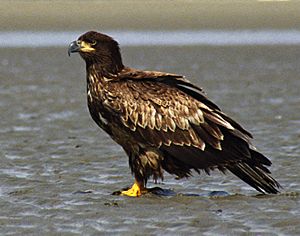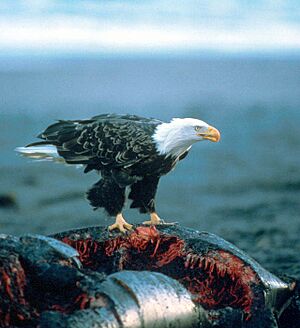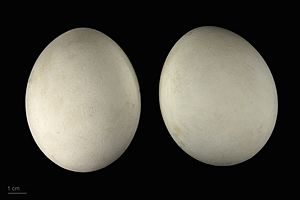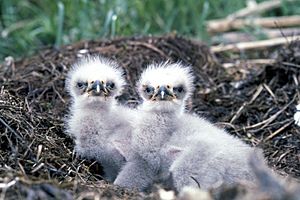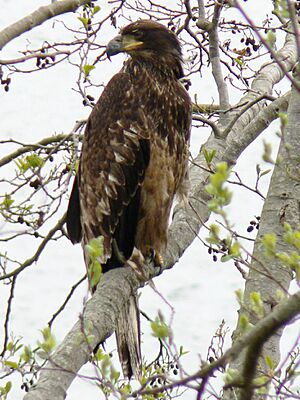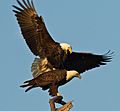Bald eagle facts for kids
The bald eagle (Haliaeetus leucocephalus) is a large bird of prey that lives in North America. It is the national bird of the United States of America.
This amazing bird is a type of sea eagle. You can find it in most of Canada, all of the United States, and the northern part of Mexico. Bald eagles love to live near big areas of water, like rivers and lakes. They need tall trees nearby to build their nests and find plenty of food.
It's called "bald" because of its white head and neck. The word "bald" here comes from an old word meaning "white-headed."
The bald eagle almost disappeared from the United States in the late 20th century. But thanks to conservation efforts, its numbers are now much stronger!
Quick facts for kids Bald eagle |
|
|---|---|
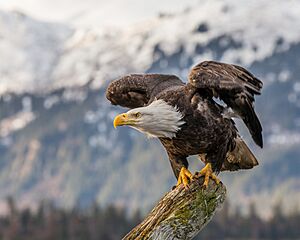 |
|
| Bald eagle preparing to fly at Kachemak Bay in Alaska, United States | |
| Conservation status | |
| Scientific classification | |
| Genus: |
Haliaeetus
|
| Species: |
leucocephalus
|
| Subspecies | |
|
|
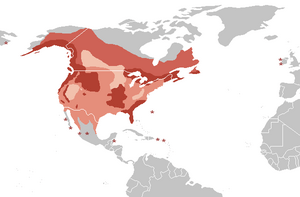 |
|
| Bald eagle range
Breeding resident Breeding summer visitor Winter visitor On migration only Star: accidental records |
|
Contents
What Does a Bald Eagle Look Like?
The bald eagle is a very large bird. It usually stands about 70 to 102 centimeters (28 to 40 inches) tall. Its wings can spread out to an amazing 2.44 meters (8 feet)!
Female eagles are bigger than males. Adult females weigh about 5.8 kilograms (12.8 pounds). Males weigh around 4.1 kilograms (9 pounds).
Adult bald eagles have a brown body with a white head and tail. They also have bright yellow feet with huge talons (claws). Their beak is yellow and hooked. Both males and females have the same feather colors.
Young bald eagles look different. Their wings are brown and often have white speckles. They keep these colors until they are about five years old.
The size of the bird depends on where it lives. The smallest bald eagles are found in Florida. There, an adult male might weigh only 2.3 kilograms (5 pounds). The largest ones live in Alaska. Big females there can weigh up to 7.5 kilograms (16.5 pounds).
Bald eagles are related to the golden eagle. But bald eagles have bigger heads and beaks. Also, their legs do not have feathers, unlike golden eagles.
When bald eagles "talk," they make weak chirps and whistles. Young birds make shriller sounds than adults.
In nature, bald eagles usually live for about 20 years. Some can live for 30 years. If they live in zoos, they can live much longer.
Why is it Called "Bald"?
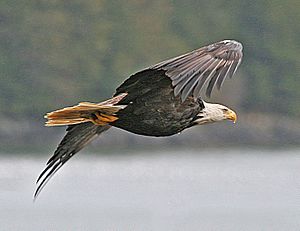
This sea eagle gets its name from its white head. The word "bald" in its name comes from an old English word, "piebald." This word means "having a white head."
Its scientific name, Haliaeetus leucocephalus, also describes its head. Haliaeetus is Latin for "sea eagle." Leucocephalus means "white head."
The famous scientist Carl Linnaeus first described the bald eagle in his 18th-century book Systema Naturae. Linnaeus created the system we use today to name living things.
There are two main types of bald eagles, called subspecies:
- H. l. leucocephalus was named by Linnaeus in 1766. This type is found in the southern United States and Baja California.
- H. l. washingtoniensis was named by Audubon in 1827. This northern type is larger than the southern one. It lives in the northern United States, Canada, and Alaska.
The bald eagle looks a lot like the Eurasian white-tailed eagle. Both birds have white heads and are about the same size. These two types of eagles likely separated long ago near the North Pacific Ocean. The white-tailed eagle lives in Eurasia, and the bald eagle lives in North America.
Where Do Bald Eagles Live?

The bald eagle's natural home is across most of North America. This includes most of Canada, all of the United States, and northern Mexico.
Most bald eagles live near large bodies of water. They like seas, rivers, big lakes, and oceans. These places have lots of fish, which is their favorite food.
Bald eagles need strong, old trees to live, sleep, and build their nests. They prefer trees that are safe from predators. The most important thing is that the trees are close to water.
Bald eagles usually prefer to be away from humans. They are mostly found in wild places with few people. However, some bald eagles have started living in city parks. For example, a family of bald eagles recently moved into Harlem, in New York City!
How Do Bald Eagles Behave?
Bald eagles are fast flyers. They can glide or flap their wings at speeds of 56–70 kilometers per hour (35–43 mph). When carrying a fish, they fly a bit slower, around 48 km/h (30 mph). They can dive at speeds of 120–160 km/h (75–99 mph), but they don't dive very often.
Many bald eagles migrate, meaning they travel long distances between their summer and winter homes. If a bald eagle's home has water that stays unfrozen all year, it might stay there. But if the water freezes in winter, the eagle must fly south or to the coast to find food.
What Do Bald Eagles Eat?
Bald eagles mostly eat fish. In the Pacific Northwest, they especially love to eat spawning trout and salmon.
Sometimes, eagles eat carrion (dead animals), especially in winter. They might also eat leftover food from campsites or garbage dumps.
They also hunt other animals. These include rabbits, hares, raccoons, muskrats, beavers, and even young deer. They also eat birds like ducks, gulls, and geese. Reptiles, amphibians, and crabs are also part of their diet.
To catch fish, an eagle swoops down over the water. It snatches the fish with its strong talons. They eat by holding the fish with one talon and tearing the meat with the other. Eagles have special bumps on their toes called "spiricules" that help them hold slippery fish.
Bald eagles have incredibly powerful talons. They have even been seen flying with a 7-kilogram (15-pound) young deer! Sometimes, if a fish is too heavy, the eagle might be pulled into the water. They can sometimes swim back to shore, but they might also drown or get too cold.
Bald eagles are at the top of their food chain. Healthy adult bald eagles are not hunted by other animals in the wild.
How Do Bald Eagles Reproduce?
Bald eagles become adults when they are four or five years old. When they are ready to mate, they usually return to the place where they were born.
It is believed that bald eagles mate for life. However, if one mate dies or disappears, the other will find a new partner. If a pair tries for a long time but cannot have chicks, they might split up and look for new mates.
When bald eagles court each other, they make calls and show off their flying skills. Two mates might fly high into the sky. Then, they lock their talons together and tumble downwards. They only let go right before they hit the ground!
The bald eagle's nest is the largest of any bird in North America. This is because they use the same nest year after year. Each year, they add more to it. A nest can become 4 meters (13 feet) deep and 2.5 meters (8 feet) across. It can even weigh 1 ton! One nest in Florida was found to be 6.1 meters (20 feet) deep and 2.9 meters (9.5 feet) across. It weighed 3 tons!
Nests are built from branches, usually in large trees near water. If there are no trees, bald eagles will build their nests on the ground.
Eagles lay between one and three eggs each year. Both the male and female take turns sitting on the eggs to keep them warm. The other parent will hunt for food or gather more material for the nest. The eggs are about 73 millimeters (2.9 inches) long.
Bald Eagles and Humans
Their Comeback Story
Once, bald eagles were common across the United States. But they almost became extinct because of a pesticide called DDT. DDT made the eagles' eggshells too thin. The eggs would break when the parents sat on them.
In the early 1700s, there were 300,000–500,000 bald eagles. But by the 1950s, only 412 nesting pairs were left in the United States. Other problems included losing their homes (habitat) and illegal hunting. Oil and lead poisoning also caused many deaths.
The bald eagle was first protected in the United States and Canada by the 1918 Migratory Bird Treaty. In 1940, the Bald Eagle Protection Act in the U.S. also helped stop the killing of bald and golden eagles. The bald eagle was listed as an endangered species in 1967. Penalties for harming them became stricter. Also, in 1972, DDT was banned in the United States. Canada completely banned DDT in 1989.
Because of all this hard work, the bald eagle population began to grow again. It was officially removed from the United States list of endangered species on July 12, 1995.
Caring for bald eagles in zoos requires experienced workers. Eagles can live a long time in zoos if well cared for. However, they do not mate well in captivity.
The National Bird of the United States
The bald eagle is the national bird of the United States. It appears on most of its official seals. This includes the Seal of the President of the United States. On June 20, 1782, the Continental Congress chose a design for the Great Seal of the United States. It showed a bald eagle holding thirteen arrows and an olive branch with thirteen leaves in its talons.
The bald eagle can be found on national seals and on the back of several coins. This included the quarter dollar coin until 1999. Between 1916 and 1945, the Flag of the President of the United States showed an eagle facing to its left.
There's a popular story that Benjamin Franklin once wanted the wild turkey to be the symbol of the United States instead of the bald eagle. However, there is no real proof that this is true. The story comes from a letter Franklin wrote to his daughter in 1784. But that letter was about a different topic and didn't mention the bald eagle or wild turkey as national symbols.
In Native American Culture
The bald eagle is a sacred bird in some North American cultures. Its feathers are considered very special. They are used a lot in spiritual customs among Native Americans. Eagles are often seen as messengers between gods and humans.
Eagle feathers are often used in traditional items, especially in fans. For example, the Lakota people give an eagle feather as a symbol of honor to someone who achieves something important. Today, it might be given for an event like graduating from college. The Pawnee people saw eagles as symbols of nature and fertility. This is because their nests are built high up, and they bravely protect their young. The Choctaw people believed the bald eagle, which can look directly at the sun, is a symbol of peace.
During the Sun Dance, performed by many Native American tribes, the eagle is included in many ways. A whistle made from an eagle's wing bone is used during the dance. Also, a medicine man might direct his fan, made of eagle feathers, toward people who need healing. The fan is then held up to the sky, so the eagle can send prayers for healing to the god.
However, Native American tribes cannot use bald or golden eagle feathers for their religious or spiritual use anymore. This is because of a law called the eagle feather law. This law usually helps Native Americans by allowing exceptions to wildlife laws. But it currently does not allow Native American tribes to use eagle feathers. This has made Native American groups upset. They say it stops them from practicing their religion freely.
Interesting Facts About the Bald Eagle
- They build the biggest bird nests in the world.
- Eagles can see both in front of them and to the sides at the same time. This gives them a very wide view.
- People sometimes put cameras near eagle nests. This lets people watch the eagles live on the internet.
- Bald eagles live about 20 years on average. Some have been known to live much longer.
- Bald eagles can swim!
- Sometimes, small dogs and cats can be attacked or carried away by eagles.
- Bald eagles don't have a loud, impressive call. They have a small whistle. In TV shows and movies, their sound is usually replaced by the call of a Red-tailed hawk.
Images for kids
-
Bald eagle in flight at Yellowstone National Park, Wyoming
-
During training at the Canadian Raptor Conservancy, a facility licensed by the province of Ontario
-
With freshly caught fish in Kodiak
-
Feeding on catfish and other various fishes. Painted by John James Audubon
-
In Skagit Valley, Washington, United States
-
Chick at Everglades National Park
-
Inside a waste collection and transfer facility, in Homer, Alaska, United States
-
Lady Baltimore, a bald eagle in Alaska who survived a poaching attempt, in her Juneau Raptor Center mews, on August 15, 2015
See also
 In Spanish: Águila calva para niños
In Spanish: Águila calva para niños



